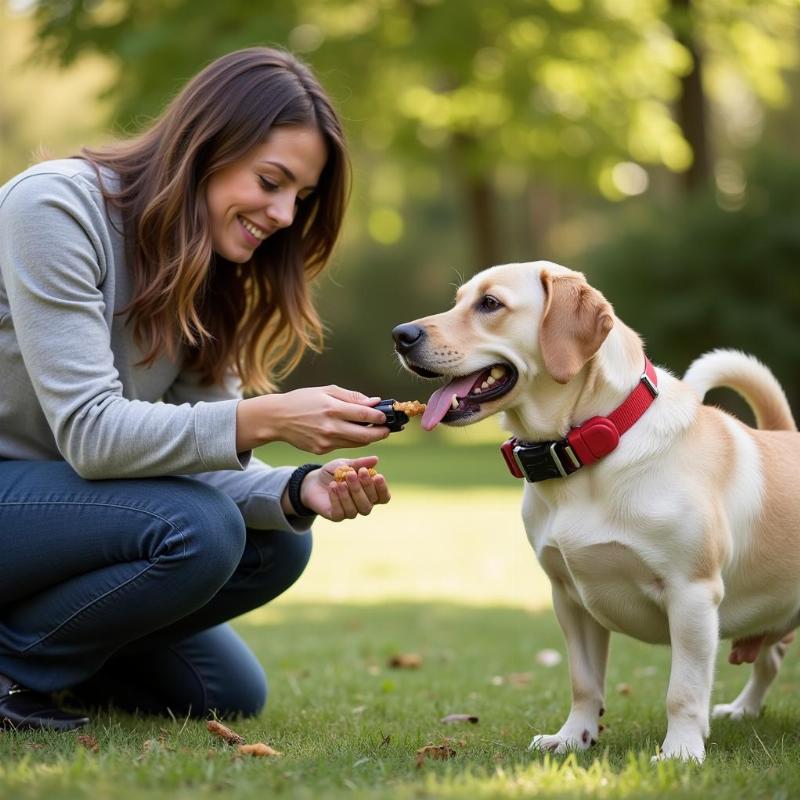No shock dog training collars offer a gentler alternative to traditional shock collars, prioritizing positive reinforcement and humane training methods. These collars use vibrations, beeps, or other sensory cues to redirect your dog’s attention and discourage unwanted behaviors without inflicting pain. This comprehensive guide will explore the benefits, features, and effective use of no shock dog training collars for a happier, well-behaved companion.
Understanding No Shock Dog Training Collars
Why choose a no shock collar? Simply put, they’re kinder. While traditional shock collars deliver an unpleasant electric jolt, no shock collars use alternative stimuli like vibrations or beeps. This makes them a much more humane option, especially for sensitive dogs. They’re also an excellent tool for positive reinforcement training, allowing you to interrupt unwanted behaviors and redirect your dog’s focus towards desired actions. Think of it as a gentle nudge in the right direction, rather than a harsh punishment. This positive approach builds trust and strengthens the bond between you and your furry friend.
Types of No Shock Collars
There are several types of no shock collars available, each designed with specific features:
-
Vibration Collars: These collars deliver a pulsing vibration, similar to a phone vibrating, to get your dog’s attention. The intensity of the vibration can usually be adjusted to suit your dog’s sensitivity.
-
Beep Collars: Beep collars emit an audible tone that serves as a warning or attention-grabbing signal. These are particularly effective for recall training or for interrupting barking.
-
Spray Collars: While not technically “no shock,” spray collars release a burst of citronella spray, which dogs find unpleasant but harmless. This can be a good option for curbing excessive barking.
-
Combination Collars: Many no shock collars combine features like vibration and beep, offering more versatility in training.
Choosing the Right No Shock Collar
Selecting the right no shock collar depends on several factors, including your dog’s size, temperament, and the specific behaviors you’re addressing. For smaller dogs, a lighter and less intense collar is ideal. For more stubborn breeds, a collar with adjustable vibration or beep settings might be necessary.
Consider the range of the collar, especially if you’re working on recall training in a larger area. A longer range ensures the signal reaches your dog even at a distance. Battery life is another important factor. Look for collars with rechargeable batteries to avoid frequent replacements.
Training with a No Shock Collar
The key to successful training with a no shock collar is consistency and positive reinforcement. Start by introducing the collar gradually, letting your dog get used to the feel and the sensation of the vibration or beep. Pair the collar with verbal commands and hand signals. For example, if you’re training recall, use the beep or vibration along with the command “Come!” and a hand gesture. When your dog responds correctly, reward them with praise, treats, or a favorite toy.
 Effectively Training a Dog with a No Shock Collar
Effectively Training a Dog with a No Shock Collar
Are No Shock Collars Safe?
Yes, no shock collars are generally safe when used correctly. They’re designed to provide sensory feedback, not pain. However, it’s important to follow the manufacturer’s instructions and avoid overusing the collar. Always supervise your dog while they’re wearing the collar and ensure it fits properly.
Addressing Common Issues
Some dogs might initially be startled by the vibration or beep. Start with the lowest setting and gradually increase the intensity as needed. If your dog seems uncomfortable or stressed, discontinue use and consult with a certified dog trainer or veterinarian.
Conclusion
No shock dog training collars offer a humane and effective way to train your dog. By utilizing positive reinforcement and consistent training methods, these collars can help you address unwanted behaviors and build a stronger bond with your canine companion. Remember to choose the right collar for your dog’s needs and always prioritize their well-being throughout the training process.
FAQ
-
Are no shock collars effective for all dogs? While they work well for most dogs, their effectiveness can vary based on the dog’s temperament and the consistency of training.
-
Can I use a no shock collar on a puppy? Yes, but it’s crucial to choose a collar designed for puppies and use the lowest settings.
-
How long does it take to see results with a no shock collar? Results vary, but with consistent training, you should see improvement within a few weeks.
-
What if my dog doesn’t respond to the no shock collar? Try adjusting the intensity or consult with a professional dog trainer.
-
Can I leave the no shock collar on my dog all the time? No, it’s recommended to only use the collar during training sessions.
-
Are there any side effects of using a no shock collar? When used correctly, there are typically no side effects.
-
What’s the difference between a no shock collar and an e-collar? E-collars often deliver electric shocks, while no shock collars use vibrations, beeps, or other sensory cues.
invisible dog fence for 2 dogs
dog bark collars for small dogs
Beautdogs.us is your premier source for all things dog-related in the US. We offer expert advice on dog breeds, care, training, and product recommendations. Whether you’re a new dog owner or a seasoned expert, Beautdogs.us has everything you need to ensure your furry friend lives a happy and healthy life. Contact us today for personalized support: Email: [email protected], Phone: +1 501-555-7529. Visit Beautdogs.us to learn more.